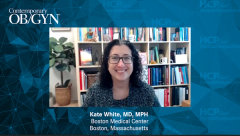
Insights From an OB/GYN and Cardiologist on Hormonal Contraceptive Selection
Drs Kate White and Harold Bays share their insights on hormonal contraceptive options and highlight the potential increase in venous thrombosis events in patients with high BMI.
Episodes in this series

Kate White, MD, MPH: When I’m talking about hormonal methods of contraception, I first want to educate patients about what kind of hormones we’re talking about and what each of these hormones do, meaning that a lot of patients don’t understand that it’s the progestin component of birth control that prevents them from getting pregnant. Estrogen is sometimes added to birth control for better cycle control. The 2 methods do work well together, but the progestin component is the most important, which is why we can have methods that just have progestin in it. Over time, formulations of birth control have changed a lot. The progestins that we use have changed in their doses. The amount of estrogen we use has been lowered, which is safer for everyone, but there are still different risk profiles for using both of these hormones. Anyone who is using a method that has estrogen in it needs to be counseled that they are at an increased risk of venous thromboembolism and side effects like that. But, for patients who have a cardiac history, or have other risk factors, they may be at an even increased risk of adverse events and patients may want to take that into consideration. There are certain conditions that a patient may have that would have me recommend that they, for instance, don’t use methods with estrogen in it. Whether this is high blood pressure, even if it’s well controlled migraines with aura, complicated valvular disease, or certain kinds of history of heart disease, may make them better candidates for either progestin-only methods, or methods that don’t have hormones at all.
Harold Bays, MD: Whenever you talk about the potential use of contraceptives in women with heart disease, you first have to give a little definition about exactly what do we mean by heart disease. Women who are going to get contraceptives are going to obviously be younger than, for example, women who are treated with postmenopausal estrogen replacement therapy. Within those 2 different populations, there’s going to be difference in the prevalence of certain sorts of cardiac conditions. In the younger class of women, you may more likely have cardiac conditions such as cardiac arrhythmias, which increase the risk of thrombosis, valvular heart disease, and congenital heart defects, which increase the risk of thrombosis, cardiomyopathy, and microvascular disease. Yes, there is some cardiovascular disease among even younger women, but my point is across the board one of the things, particularly again with younger women, that we focus upon when we have women with heart disease is that we want to focus in on considerations of thrombosis. This would be as opposed to atherosclerosis. Don’t get me wrong, yes, younger women can get atherosclerotic cardiovascular disease, but it’s reasonable to say that the prevalence of nonatherosclerotic cardiovascular disease is more prevalent among younger women.
You have to weigh out the complications of having the contraceptives as opposed to having no contraceptives. Overall, what I would say is primum non nocere, which means first, do no harm, and it’s appropriate when considering contraceptives in women that you look at the totality of the patient. If the female has heart disease, you find out if she has an increase in body mass index, and therefore, is at risk for thrombosis and then, make a decision whether estrogen containing contraceptives make the most sense, or maybe you should consider an alternative like intrauterine devices, or if you’re taking pills, a progestin-only formulation.
In women who have increases in body mass index, what we’re talking about here is the overweight, or in many cases what we’re talking about is obesity. Within the framework of obesity, you have what we call sick fat disease, or you have fat mass disease. You have all sorts of neuropathies and endocrinopathies that among many things can increase the risk of the diabetes and the hypertension, dyslipidemia, but also increase that risk of thrombosis. At the same time, you have that fat mass disease where you have increase in pressure, you have compression of veins, and diminished venous returns so that fat mass disease also increases the risk of thrombosis. For women who have increases in body mass index, whether it be the immunos, or the endocrinopathies associated with the overweight and the obesity, or whether it’s the fat mass disease where the compression of venous return. One of the primary considerations and primary concerns among women with increase in body mass index would be their increased risk of thrombosis. I’m saying this specifically with regard to choices that might be made with regard to oral contraceptives.
The use of a hormonal contraceptive, we have a history there. Back in the day, the oral contraceptives used much higher doses of estrogen than we currently use today. Why was that a problem? The reason it was a problem because it increased the risk of thrombosis and stroke. The idea was to see if we could reduce the estrogen content and yet remain efficacious in providing contraception. That’s one of the reasons why it is that we have lower estrogen concentration in the oral contraceptives. That said, there’s still estrogen there and, as most clinicians know, estrogen tends to polarize more towards thrombosis than anti-thrombosis. It increases the risk again of thrombosis. If you have what we call sick fat disease, or the endocrinopathies or the neuropathies that promote that thrombosis and you add to that the fat mass disease with compression of venous return, then you’re favoring the thrombosis over the anti-thrombosis and that predisposes to a thrombotic state. In totality, that’s just a brief description as to why estrogens are generally associated with an increased risk of thrombosis and stroke.
Transcript Edited for Clarity
Newsletter
Get the latest clinical updates, case studies, and expert commentary in obstetric and gynecologic care. Sign up now to stay informed.











